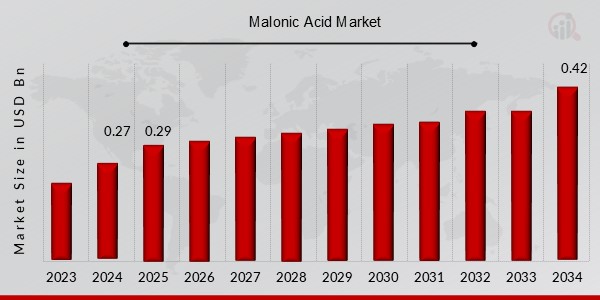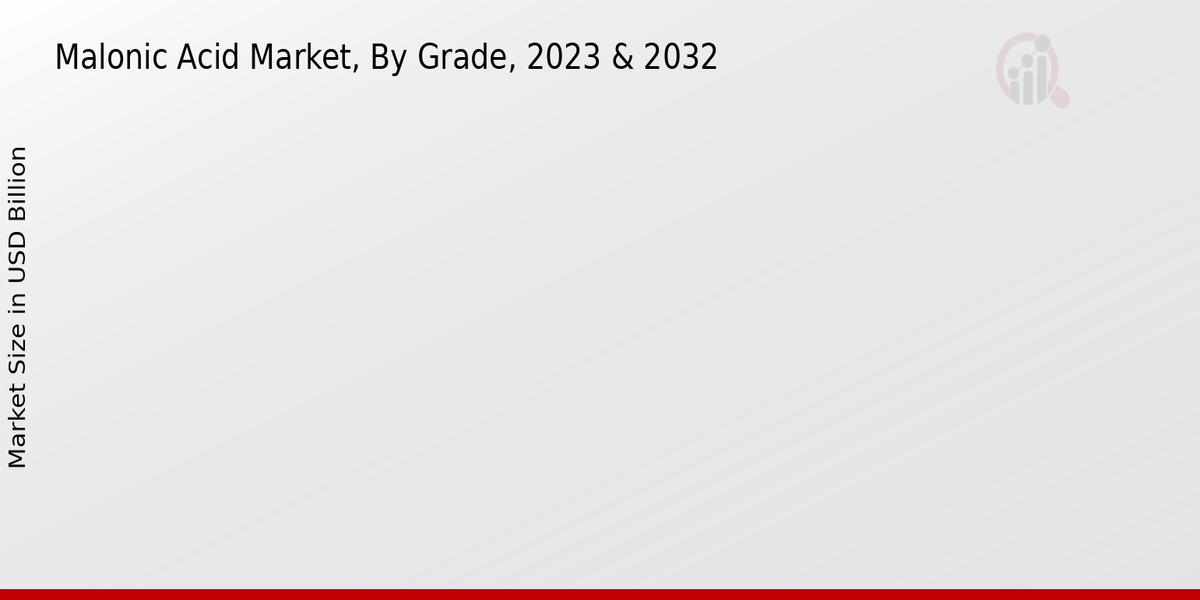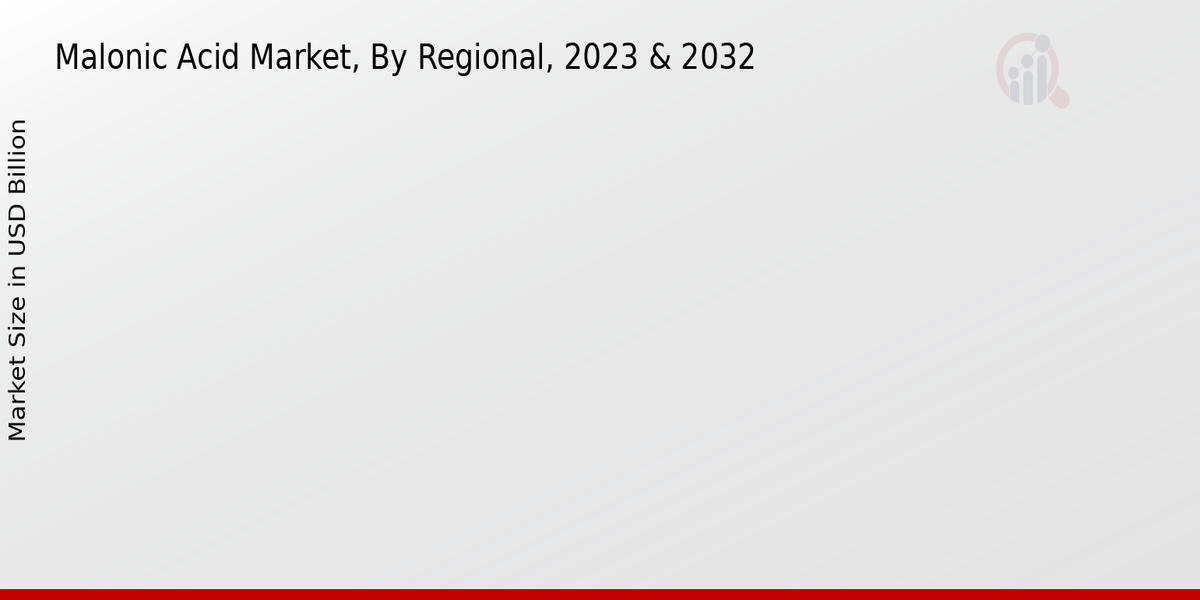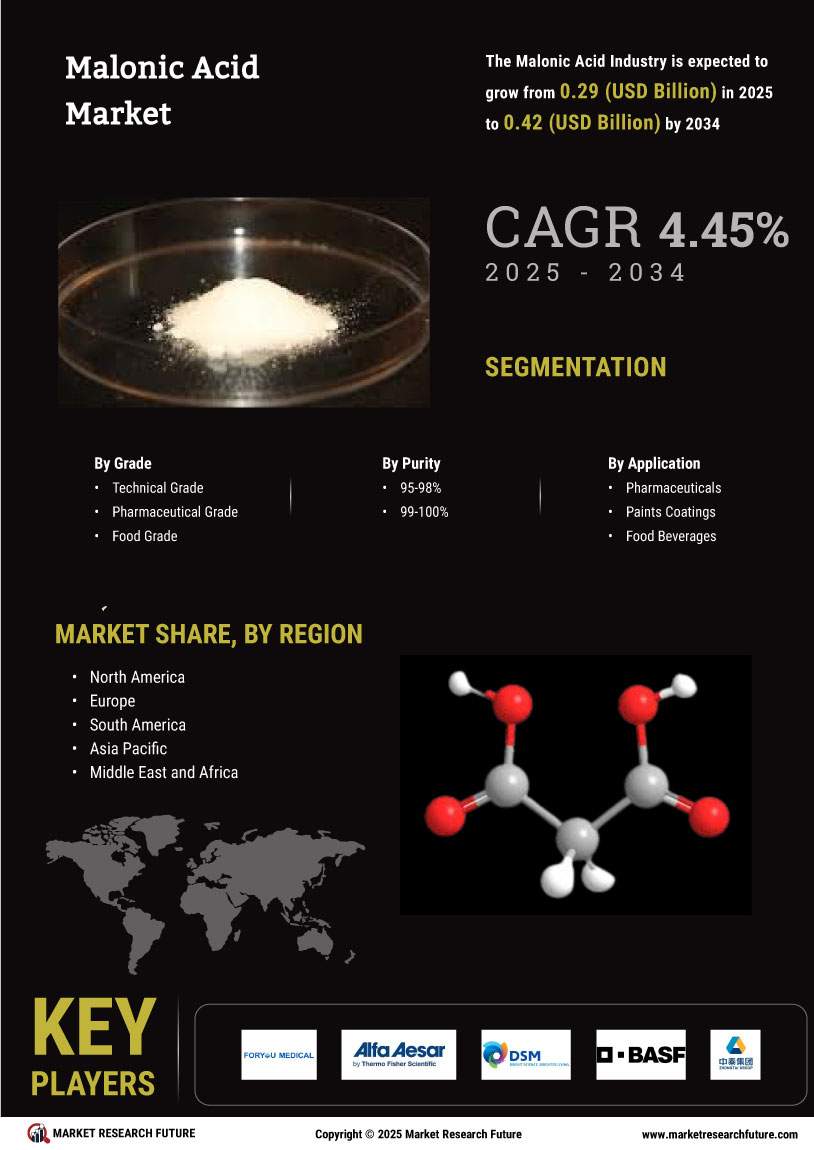Global Malonic Acid Market Overview
Malonic Acid Market Size was estimated at 0.27 (USD Billion) in 2024. The Malonic Acid Industry is expected to grow from 0.29 (USD Billion) in 2025 to 0.42 (USD Billion) by 2034. The Malonic Acid Market CAGR (growth rate) is expected to be around 4.45% during the forecast period (2025 - 2034).
Key Malonic Acid Market Trends Highlighted
Key market drivers for malonic acid include its increasing demand in the production of bioplastics, pharmaceuticals, and personal care products. Moreover, growing consumption in the food and beverage industry as an acidulant and preservative is further propelling market growth.
Recent trends in the malonic acid market indicate a shift towards sustainable and eco-friendly production methods. Consumers are increasingly seeking bio-based and biodegradable alternatives, creating opportunities for manufacturers to explore novel production technologies using renewable feedstocks.
Additionally, advancements in downstream industries such as pharmaceuticals and personal care are expected to drive innovation and new product development, contributing to the overall growth of the malonic acid market.

Source: Primary Research, Secondary Research, MRFR Database and Analyst Review
Malonic Acid Market Drivers
Increasing Demand for Biodegradable Plastics
Heightened distresses over environmental contamination and the exhaustion of petroleum products resources has continuously raised interest in biodegradable plastics. Malonic acid is a key raw material for the production of polymalic acid, the biodegradable polymer which displays excellent barrier properties and biodegradability. The potential applications of PMA, including food packaging, agricultural films, and medical products, are anticipated to drive the market for malonic acid.The Malonic Acid Market Industry is projected to grow from USD 0.25 billion in 2023 to USD 0.37 billion by 2032, at a CAGR of 4.45% over the forecast period. Demand for biodegradable plastics is driving the Asia-Pacific region to be the fastest-growing region in the malonic acid market. The increasing awareness of the poisonous impacts of conventional plastic and supportive administration rules is anticipated to drive the request for malonic acid.Increasing demand for bio-based chemicals and materials is expected to drive the malonic acid market. Malonic acid is a naturally existing chemical used as a construction raw material for the creation of chemicals such as bio-based solvents, plasticizers, and lubricants. Requests for bio-based chemicals are likely to drive interest in malonic acid, bracing up the industry for malonic acid.
Growing Applications in the Pharmaceutical Industry
Malonic acid is extensively used in the pharmaceutical industry as an intermediate in the synthesis of diverse active pharmaceutical ingredients. It is used in the production of antibiotics, anti-inflammatory pharmaceuticals, anti-cancer drugs, etc. The continuing growth of the pharmaceuticals market combined with the increasing share of malonic acid in drug synthesis will drive the growth of the market. The Malonic Acid Market Industry will grow from $0.25 billion in 2023 to $0.37 billion by 2032, with a 4.45% CAGR during the forecast period.The pharmaceutical industry will be one of the prime end-use markets for malonic acid, reserved to experience considerable growth. There will be multiple factors contributing to the strong demand for these products. They include the continuous expansion of the percentage of the world’s population that suffers from various chronic diseases and the demand for innovative drugs.
Expansion of the Food and Beverage Industry
Malonic acid is commonly used in the food and beverage industry as a flavoring agent and acidity regulator. The utilization areas are soft drinks, candies, and baked goods. The constant growth of the processed food and beverages demand, combined with a growing number of customers that prefer only natural or organic ingredients, stimulates the numeration of malonic acid all over the globe. The Malonic Acid Market Industry Market will increase from USD 0.25 billion in 2023 to USD 0.37 billion by 2032, developing at a CAGR of 4.45% through the review period.The food and beverage industry is expected to remain the most prominent application of malonic acid, promoting the growth of the market. In addition, the rapidly developing industry of convenience food and the growing utilization of functional food and beverages will also boost the demand for this element.
Malonic Acid Market Segment Insights
Malonic Acid Market Grade Insights
The Malonic Acid Market is segmented by grade into Technical Grade, Pharmaceutical Grade, and Food Grade. The Pharmaceutical Grade segment is estimated to be the largest segment in 2023 and is expected to continue to dominate the market over the forecast period. The growth of this segment can be attributed to the increasing demand for malonic acid in the pharmaceutical industry, particularly for the production of barbiturates and other drugs. The Technical Grade segment is expected to grow significantly over the forecast period due to the increasing demand for malonic acid in several industrial applications, such as the production of dyes, plastics, and chemicals.The Food Grade segment is projected to grow at a steady pace during the forecast period owing to the increasing consumption of malonic acid in the food and beverage industry, mainly in the production of flavorings and preservatives. The growth of the market can be attributed to the increasing application of malonic acid in various industries, including pharmaceuticals, chemicals, and food and beverages. Moreover, the market is likely to benefit from the ongoing trend of bio-based products and the increasing demand for eco-friendly chemicals.

Source: Primary Research, Secondary Research, MRFR Database and Analyst Review
Malonic Acid Market Purity Insights
One of the persistent segments in the Malonic Acid Market that affects the growth and overall functioning of the industry is purity. Malonic acid 99-100%’ has the biggest market share due to the fact that it obtains high purity, and thus, it is relevant for the work of numerous companies and laboratories focused on the production of pills, vitamins, and other pharmaceuticals as well as the production of food additives and daily use goods. Moreover, it is used in the chemical industry where the precise formula must be introduced in order to produce the highest quality of items. Meanwhile, the 95-98%’ segment also has a large share as the items with such levels of purity can be utilized in the production of plastics and coatings. From the market data, it is possible to make a conclusion that both segments have an overall tendency to growth, and the use of the two types of malonic acid can be found across various industries.
Malonic Acid Market Application Insights
The Malonic Acid Market segmentation by Application comprises Pharmaceuticals, Paints Coatings, Food Beverages, Electronics, and Personal Care Products. The Pharmaceuticals segment held the largest market share in 2023, accounting for over 35% of the Malonic Acid Market revenue. Malonic acid is used in the production of pharmaceuticals such as barbiturates, anticonvulsants, and hypnotics. The Paints Coatings segment is expected to witness significant growth over the forecast period, driven by the growing demand for malonic acid in the production of alkyd resins, which are used in paints and coatings.The Food Beverages segment is also expected to contribute to the growth of the Malonic Acid Market, as malonic acid is used as a food additive and flavoring agent. The Electronics segment is expected to witness moderate growth, driven by the use of malonic acid in the production of electronic components. The Personal Care Products segment is expected to grow steadily, driven by the increasing use of malonic acid in the production of cosmetics and personal care products.
Malonic Acid Market Regional Insights
The regional segmentation of the Malonic Acid Market offers crucial insights into the market's geographical distribution and performance. North America holds a significant share of the market, driven by the presence of major chemical and pharmaceutical industries. Europe follows closely, with a strong demand from the automotive and food additives sectors. The Asia-Pacific region is projected to witness significant growth over the forecast period, owing to the rising demand from emerging economies like China and India. South America and the Middle East and Africa (MEA) regions are expected to contribute a smaller share to the overall market, but offer potential for growth in the coming years.Key factors influencing the regional market dynamics include government regulations, economic conditions, and technological advancements.

Source: Primary Research, Secondary Research, MRFR Database and Analyst Review
Malonic Acid Market Key Players And Competitive Insights
The main competitors in the malonic acid market consist of BASF SE and Eastman Chemical Company. BASF SE is a leading German chemical company that produces malonic acid and has a strong presence and diverse product portfolio. The company grows its production capacity of malonic acids and enlarges its distribution network within emerging markets. Additionally, BASF SE invests significant capital in research and development and works on different applications of malonic acid, one of which is the development of bio-based plastics. Eastman Chemical Company is a strong American chemical company that heavily develops its production capacity and application of malonic acids. The company has a strong presence and growing influence in the Americas and Europe and in rapidly growing Asia. Eastman Chemical Company develops different applications of malonic acids, such as for pharmaceuticals and personal care. The company is also working on the production of malonic acid by establishing research on novel technologies.Other main competitors in this market, namely, Lonza Group Ltd and Nantong Senos Biotechnology Co, are also actively working on research of new malonic acid applications. These companies include personal care and integrated pharmaceutical technologies development into malonic acid research. Another competitor, Nanjing Lianshi, concentrated on the hospital application of malonic acid. To increase its competitiveness, this competitor partners with the local government and intends to invest heavily in research of the malonic acid applications. The competitive landscape of the malonic acid market will likely remain competitive; companies will continue to heavily compete for research, strategic partnership, acquisition, expanding distribution network, and development of new products.
Key Companies in the Malonic Acid Market Include
- Zibo Xiwang Group
- New York Chemical
- Huizhou Foryou
- Anhui Jianghuai Biochemistry
- Alfa Aesar
- DSM
- Changzhou Yangtze River Group
- BASF
- Yixin
- Yancheng Zhongtai Chemical
- Yantai Wanhua
- Jishun Chemical
- Linyi Wanhua Chemicals
- Achive Bio
- Shandong Leyi Biotechnology
Malonic Acid Market Industry Developments
The malonic acid market is expected to reach USD 0.42 billion by 2034, exhibiting a CAGR of 4.45% during the forecast period of 2025-2034. Rising demand for malonic acid in the production of pharmaceuticals, food additives, and personal care products is driving market growth.In recent news, BASF announced the expansion of its malonic acid production capacity at its Ludwigshafen site in Germany. This expansion is expected to meet the growing demand for malonic acid in various industries. Additionally, the increasing use of malonic acid in biodegradable plastics is expected to drive market growth in the coming years.
Malonic Acid Market Segmentation Insights
Malonic Acid Market Grade Outlook
- Technical Grade
- Pharmaceutical Grade
- Food Grade
Malonic Acid Market Purity Outlook
Malonic Acid Market Application Outlook
- Pharmaceuticals
- Paints Coatings
- Food Beverages
- Electronics
- Personal Care Products
Malonic Acid Market Regional Outlook
- North America
- Europe
- South America
- Asia Pacific
- Middle East and Africa
| Report Attribute/Metric |
Details |
| Market Size 2024 |
0.27 (USD Billion) |
| Market Size 2025 |
0.29 (USD Billion) |
| Market Size 2034 |
0.42 (USD Billion) |
| Compound Annual Growth Rate (CAGR) |
4.45% (2025 - 2034) |
| Report Coverage |
Revenue Forecast, Competitive Landscape, Growth Factors, and Trends |
| Base Year |
2024 |
| Market Forecast Period |
2025 - 2034 |
| Historical Data |
2020 - 2024 |
| Market Forecast Units |
USD Billion |
| Key Companies Profiled |
Zibo Xiwang Group, New York Chemical, Huizhou Foryou, Anhui Jianghuai Biochemistry, Alfa Aesar, DSM, Changzhou Yangtze River Group, BASF, Yixin, Yancheng Zhongtai Chemical, Yantai Wanhua, Jishun Chemical, Linyi Wanhua Chemicals, Archive Bio, Shandong Leyi Biotechnology |
| Segments Covered |
Grade, Purity, Application, Regional |
| Key Market Opportunities |
1 Increasing demand from the food and beverage industry2 Growing applications in pharmaceuticals3 Expansion in personal care products4 Rising popularity in textile manufacturing5 Favorable regulatory environment |
| Key Market Dynamics |
Rising Demand from the Polyester Industry Growing Application in Pharmaceuticals Increasing Use in the Food and Beverage Industry Expansion of Biotechnology Sector Shifting Production to LowCost Regions |
| Countries Covered |
North America, Europe, APAC, South America, MEA |
Frequently Asked Questions (FAQ) :
The Malonic Acid Market was valued at approximately USD 0.27 Billion in 2024 and is expected to reach approximately USD 0.42 Billion by 2034, growing at a CAGR of around 4.45% between 2025 to 2034.
The key regions contributing to the Malonic Acid Market are North America, Europe, Asia-Pacific, and the Rest of the World. Among these regions, Asia-Pacific is expected to hold the largest market share over the forecast period due to increasing demand from end-use industries such as pharmaceuticals and food beverages.
Malonic Acid finds applications in various industries, including pharmaceuticals, food beverages, personal care, and others. In the pharmaceutical industry, it is used as an intermediate in the production of barbituric acid derivatives, which are used as sedatives and hypnotics. In the food and beverage industry, it is used as an acidulant, flavoring agent, and preservative. In the personal care industry, it is used in hair care products and skin care products.
Some of the key competitors in the Malonic Acid Market include BASF SE, Evonik Industries AG, Merck KGaA, Sigma-Aldrich Corporation, and TCI Chemicals.
The growth of the Malonic Acid Market is driven by several factors, including increasing demand from the pharmaceutical industry, rising demand for processed food beverages and growing awareness of personal care products. Additionally, the market is expected to benefit from the increasing adoption of bio-based products and the expansion of the nutraceuticals industry.
The Malonic Acid Market faces several challenges, including intense competition from other organic acids, fluctuating raw material prices, and stringent environmental regulations. Additionally, the market is expected to be impacted by the economic slowdown and geopolitical uncertainties.
The Malonic Acid Market presents several opportunities for growth, including the development of new applications in the pharmaceutical and food-beverage industries, the increasing demand for bio-based products, and the expansion of emerging markets. Additionally, the market is expected to benefit from the growing adoption of sustainable manufacturing practices.
Some of the key trends in the Malonic Acid Market include the increasing adoption of bio-based malonic acid, the development of new applications in the pharmaceutical industry, and the growing demand for malonic acid derivatives. Additionally, the market is expected to witness a shift towards sustainable manufacturing practices and the use of renewable energy sources.
The Malonic Acid Market is expected to grow at a CAGR of around 4.45% between 2025 to 2034. The market is expected to be driven by increasing demand from the pharmaceutical and food-beverage industries, as well as the growing adoption of bio-based products.
Key factors to consider when investing in the Malonic Acid Market include the market size and growth potential, the competitive landscape, the regulatory environment, and technological advancements. Additionally, investors should consider the impact of economic conditions and geopolitical uncertainties on the market.
















